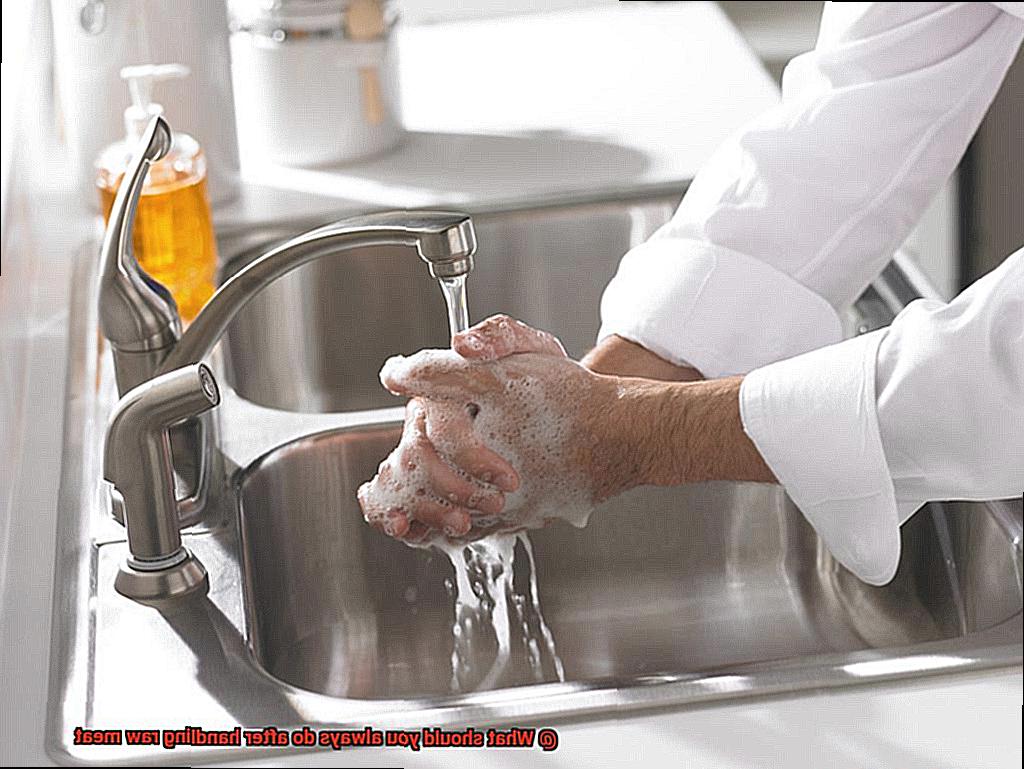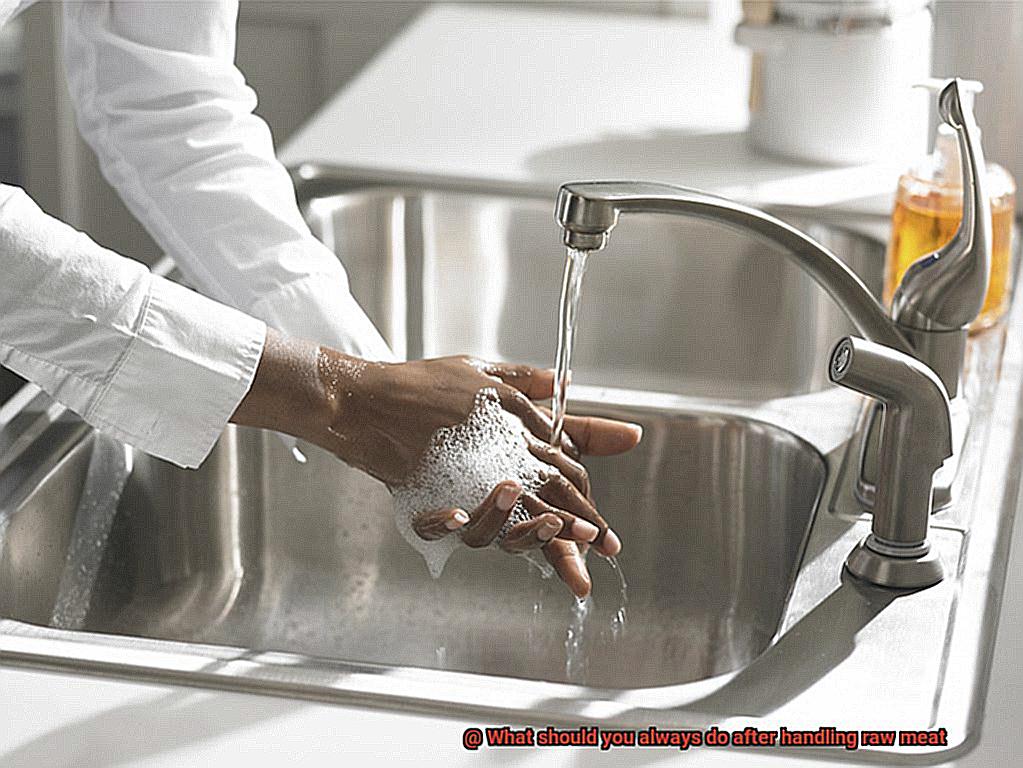Are you a meat lover? Do you enjoy preparing juicy steaks or mouth-watering BBQ chicken for your loved ones? If so, it’s crucial to know how to handle raw meat safely. Failing to follow appropriate food safety practices can lead to severe illnesses caused by harmful bacteria such as E. coli, Salmonella, and Listeria.
Raw meat is a breeding ground for dangerous germs that can be easily spread through cross-contamination. This means that bacteria can transfer from the meat to your hands, utensils, and food preparation surfaces. To avoid getting sick and ruining your meal, it’s essential to take the necessary steps after handling raw meat.
So what should you do? First and foremost, wash your hands thoroughly with soap and warm water. Don’t forget to clean any surfaces or utensils that came into contact with the raw meat using hot soapy water or a disinfectant spray. And if you’re cooking on a grill or stove-top, make sure to heat the meat until it reaches a safe internal temperature.
By following these simple yet effective food safety tips, you’ll be able to prevent cross-contamination and ensure that your meals are not only delicious but also safe for everyone at the table. So let’s get started on learning how to handle raw meat like a pro.
Contents
What is Raw Meat?
Raw meat is a term used to describe any unprocessed or uncooked meat such as beef, pork, poultry, and fish. It is important to handle raw meat with care since it can harbor harmful bacteria like Salmonella, E. coli, and Campylobacter that can cause foodborne illness.
To ensure the safe handling of raw meat, proper hygiene practices should be followed. After handling raw meat, wash your hands thoroughly with soap and warm water for at least 20 seconds. Clean any surfaces that have come into contact with the raw meat, such as knives and cutting boards, with hot, soapy water before using them again.
Storing raw meat correctly is also crucial. If you are not cooking it immediately after handling it, store it in the refrigerator or freezer right away. Leaving raw meat at room temperature for an extended period promotes the growth of harmful bacteria.
Not all raw meats are created equal. Some types of raw meat are more susceptible to bacterial contamination than others. For example, ground beef and poultry are higher risk meats because bacteria can spread throughout the meat during processing.
To prevent cross-contamination, always keep raw meat away from ready-to-eat foods. Use separate cutting boards and utensils for raw meat to avoid spreading harmful bacteria to other foods.
When cooking raw meat, it is important to ensure that it reaches a safe internal temperature to kill any bacteria present. A food thermometer can be used to check the temperature of the meat. The safe internal temperature for beef, pork, and lamb is 145°F (63°C), while poultry should be cooked to an internal temperature of 165°F (74°C).
Why is it Important to Handle Raw Meat with Care?
Well, the answer lies in the fact that raw meat is a breeding ground for harmful bacteria like E. coli, Salmonella, and Campylobacter. These bacteria can cause severe food poisoning, leading to hospitalization or even death. Therefore, it’s crucial to follow proper food safety practices to minimize the risk of contamination.
One of the primary reasons why handling raw meat with care is so important is to prevent the spread of harmful bacteria. Raw meat can contaminate other foods or surfaces in your kitchen through cross-contamination. This happens when bacteria from one food item transfer to another food item, causing serious health problems. To avoid this, ensure that you use separate cutting boards and utensils for raw meat and other foods.
Another reason why handling raw meat with care is essential is that bacteria can multiply quickly at room temperature. Therefore, it’s crucial to keep your raw meat refrigerated until you’re ready to use it. By doing this, you can minimize the growth of harmful bacteria that can cause food poisoning.
When handling raw meat, it’s vital to follow proper food safety practices such as washing your hands thoroughly before and after handling it. This helps prevent the spread of harmful bacteria from your hands to other surfaces in your kitchen. Also, ensure that you sanitize all surfaces that come into contact with raw meat to prevent cross-contamination.
Step 1: Wash Your Hands Thoroughly

Not only is it a simple step, but it is also a crucial one that can prevent the spread of harmful bacteria and keep you and your loved ones safe from foodborne illnesses.
Here are some reasons why washing your hands after handling raw meat is so essential:
Prevents the spread of bacteria: Raw meat is a breeding ground for dangerous bacteria such as Salmonella and E. coli. These bacteria can easily transfer to your hands and other surfaces that come into contact with the meat. Washing your hands immediately after handling raw meat helps to prevent their spread.
Reduces cross-contamination: If you touch other surfaces or food items after handling raw meat without washing your hands, you risk spreading the bacteria to those surfaces or food items. This can lead to cross-contamination and increase the risk of foodborne illnesses.
Ensures safe food preparation: When you wash your hands before handling any other food items or utensils after handling raw meat, you ensure that those items are safe for consumption. This step helps to prevent the spread of bacteria to other parts of your kitchen and keeps your entire meal safe for consumption.
To properly wash your hands after handling raw meat, follow these steps:
- Use warm water and soap.
- Lather for at least 20 seconds before rinsing.
- Scrub all areas of your hands, including between your fingers and underneath your nails.
- Rinse thoroughly.
- Dry your hands with a clean towel or air dryer.
Remember to wash your hands before handling any other food items or utensils after handling raw meat to prevent cross-contamination.
Step 2: Clean Surfaces that Have Come in Contact with Raw Meat
We all love to cook and experiment with different flavors, but it’s crucial to remember that handling raw meat requires proper precautions. To avoid any potential risks of foodborne illness, step two of safe food preparation is to clean surfaces that have come in contact with raw meat.
The first step in cleaning these surfaces is using hot, soapy water to wash them thoroughly. Whether it’s cutting boards, countertops, utensils, or even your hands, make sure to scrub away any bacteria or contaminants that may be lurking. To prevent cross-contamination, use a clean cloth or sponge for each surface.
After washing the surface, it’s essential to sanitize it with a solution of one tablespoon of bleach per gallon of water. This will kill any remaining bacteria, ensuring that the surface is safe to use. Remember that safety should always come first when handling raw meat.
Here are some additional pro tips: besides cleaning surfaces immediately after handling raw meat, make sure to clean them regularly throughout the cooking process. This will help prevent cross-contamination and reduce the risk of foodborne illness.
Taking the time to clean surfaces that have come into contact with raw meat is a crucial step in ensuring food safety. You don’t want harmful bacteria ruining your meal. By following these simple steps, you can protect yourself and your loved ones from potential health risks.
To recap, cleaning surfaces that have come into contact with raw meat involves:
- Washing with hot, soapy water
- Sanitizing with a solution of bleach and water
- Using a clean cloth or sponge for each surface
- Cleaning regularly throughout the cooking process
Step 3: Store the Raw Meat Properly
We all know that handling raw meat can be tricky, but proper storage is just as crucial to prevent contamination and the spread of harmful bacteria. Here are some tips for storing raw meat in the refrigerator and freezer:
First and foremost, wrap or cover your raw meat tightly with plastic wrap or aluminum foil to prevent any bacteria or juices from leaking out and contaminating other foods in the refrigerator. Always store the meat at the bottom of the refrigerator to avoid any drippings from falling onto other foods. You can also place the meat on a plate or in a container to catch any drippings.
If you plan to store your raw meat for an extended period, it is best to freeze it. Remember to label the packaging with the date and type of meat before freezing it so that you can keep track of how long it has been in the freezer. This helps you ensure that you use it before it goes bad.
When thawing frozen meat, safety should be your top priority. The best method is to thaw it in the refrigerator overnight. However, if you need to thaw it quickly, you can use a microwave or place it in a sealed plastic bag and submerge it in cold water. Do not thaw meat at room temperature as this promotes bacterial growth.
In addition, always wash your hands thoroughly after handling raw meat and clean any surfaces or utensils that came into contact with it to prevent cross-contamination.
To sum up, here are some key takeaways on how to store raw meat properly:
- Wrap or cover raw meat tightly with plastic wrap or aluminum foil
- Store raw meat at the bottom of the refrigerator to avoid contamination
- Label packaging with date and type of meat before freezing
- Thaw frozen meat safely
- Wash your hands thoroughly after handling raw meat and clean any surfaces or utensils that came into contact with it
Step 4: Avoid Cross-Contamination
Today, we’re going to discuss a crucial step in handling raw meat – avoiding cross-contamination. Cross-contamination is a serious concern as it can lead to the spread of harmful bacteria and increase the risk of foodborne illness. But don’t fret. Follow these practical steps to keep your food safe.
Firstly, always remember to clean all surfaces and utensils that come into contact with raw meat. Use hot, soapy water to thoroughly clean cutting boards, knives, and countertops. Then sanitize them with a solution of one tablespoon of bleach per gallon of water. By doing this, you’ll eliminate any bacteria that may be lingering around.
Secondly, washing your hands thoroughly after handling raw meat is an absolute must. Use warm water and soap and scrub your hands for at least 20 seconds. Dry your hands with a paper towel and discard it immediately. This simple step will help prevent the spread of bacteria from your hands to other surfaces or food items.
Lastly, storing raw meat separately is essential to prevent cross-contamination. Store raw meat in a separate container or on a different shelf in the refrigerator. To avoid any juices from dripping onto other foods, always store raw meat below ready-to-eat foods.
W5xdQUi7NiQ” >
Conclusion
In summary, proper handling of raw meat is paramount to safeguarding against harmful bacteria and ensuring that your meals are healthy and delicious. The four essential steps to take after handling raw meat include washing your hands thoroughly with soap and warm water, sanitizing any surfaces or utensils that came into contact with the raw meat using hot soapy water or a disinfectant spray, storing the meat correctly in the refrigerator or freezer, and avoiding cross-contamination.
Raw meat can harbor dangerous germs such as E. coli, Salmonella, and Listeria that can cause severe illnesses if not handled appropriately. Therefore, it’s crucial to take necessary precautions when handling raw meat to minimize the risk of contamination.
By following these simple yet effective food safety tips, you’ll be able to prevent cross-contamination and ensure that your meals are safe for everyone at the table. Always remember to wash your hands thoroughly after handling raw meat, sanitize all surfaces that come into contact with it, store it correctly in the refrigerator or freezer, and avoid cross-contamination by keeping it separate from other foods.
In conclusion, proper handling of raw meat is a straightforward process that requires basic hygiene practices. By doing this, you can protect yourself and your loved ones from potential health risks while enjoying your favorite dishes.






